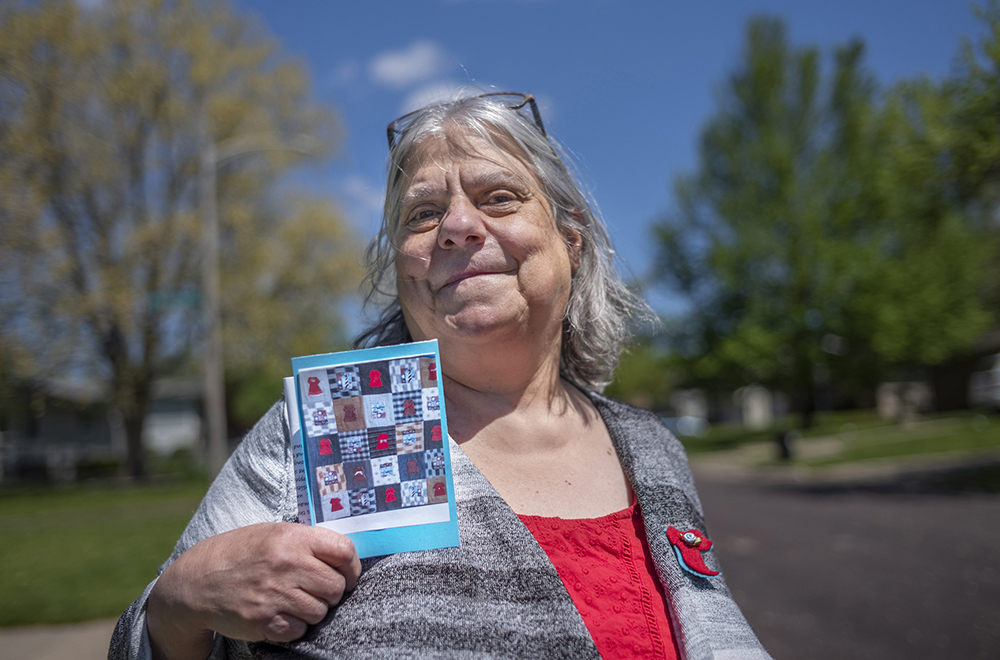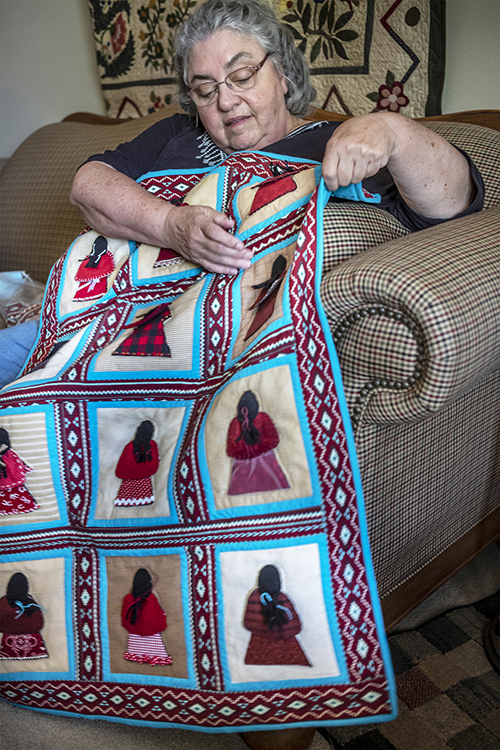
Joan Hickman holds a photo of a quilt she created depicting lighthouses to commemorate and tell a story about women who are missing and murdered. (PHOTO BY DAVID ZALAZNIK)
Editor’s Note: The REDress Project was conceived by Canadian artist Jaime Black to commemorate murdered and missing indigenous women. The REDress Project was displayed at the Smithsonian National Museum of the American Indian in 2019. Eliida Lakota brought the concept to Central Illinois with an installation at Dayspring United Methodist Church in East Peoria.
Lakota is now working with other women on a quilting project to commemorate all murdered and missing women. In the quilts, a lighthouse is symbolic for the abduction of women for sex trafficking. After being exploited, one story has it that women were taken by boat out on Lake Superior and dumped overboard in the freezing water.
The REDress Project will be presented at the Tazewell County Museum in Pekin with an exhibition and summer programming.
The REDress Project, also called MMIW (Missing and Murdered Indigenous Women), includes red dresses hung in public places, indoors and outside, to draw attention to thousands of women who have been abducted or drawn into human trafficking.
Joan Hickman and I, both members of the Dayspring Native American United Methodist Church in East Peoria, have expanded the REDress Project into a quilting project to tell the story of the abduction and exploitation of all women.
Women and children living in poverty, victims of sex abuse, substance abuse or broken and dysfunctional homes are viewed by abductors as a valuable resource.
Many women are drawn into human trafficking through social media. Abductors try to develop relationships with women by commenting on photos and posts. They gradually gain the trust of the women and arrange to meet off-line. The relationship develops into a “faux romance” and through manipulation using fear and threats, the victims become trapped in the relationship and the sex industry.
Victims come from all walks of life.
Through our art, we recognize these victimized women, promote awareness of sex trafficking and serve to caution all women about this unjust and widely unrecognized crime.
Historically, women have used quilts to express themselves and defy marginalization. Before women were even counted by the official census and before they were considered equal to men, women would sign their names to their quilts.
This was a proclamation of their existence.
During slavery, quilts were used to present ideas and to surreptitiously convey secret information about the Underground Railroad to freedom.
The wagon wheel pattern on the quilt could serve as an instruction guide for the journey to freedom.
Donna Leber joined us in our quilting project.
“I wanted to be sensitive and not introduce my own prejudices into my project. I was hoping to somehow give the victims in the quilt a voice that said ‘I was here and I was worthy,’” Leber said.
“I included some embellishments that are hidden under the shawls to entice the viewer to imagine the nature of each woman. It was important to me not to make the quilt about the dresses but rather draw the viewer in to begin imagining what it would be like to get to know the woman who wore these dresses.”
Every quilt has a story. The lighthouse quilt, created by Joan Hickman, symbolizes a lighthouse on the shores of Lake Superior where possibly as many as 10,000 women may have disappeared.
Both REDress Project and our quilting project give a platform to women and girls now silent. Our goal is to work for changes in laws and policies and the allocation of resources toward ending injustices and inequalities toward native American women and all women.
My friend Rosemary made this comment about the quilt project:
“I am not Native American but have read several novels and books about the plight of native women on the reservation and off. They are unfairly treated, demeaned, raped and even murdered. This is monumentally unfair and as a woman I would like to stand with them for more fair treatment, legal recourse and respect.
“The only real way that I could think to do this is to contribute to the REDress project with sewing and with prayers. Doing so little produces guilt but not as much as doing nothing. And sewing, assembling and praying for those fellow human beings is what is possible for me at this time. Too bad I am too old to take up arms in warrior manner.”
One of our REDress quilts will be auctioned this fall. The Native American International Caucus of United Methodist Church, consisting of over 500 Native American nations, will be hosting a native American art auction online to raise funds for advocacy for fair Native American causes. Specific auction dates will be announced in the next several months. Check the website http://www.naicumc.com
Tazewell County Museum, 2950 Court St., Pekin. For more information call 309-657-6419 or 309-347-1036

Donna Leber created this quilt to symbolize missing Indigenous women. Leber said, “The faces of the women are not seen because they represent tens of thousands of missing and murdered women – real people with lives and families.” (PHOTO BY DAVID ZALAZNIK)

Recent Comments